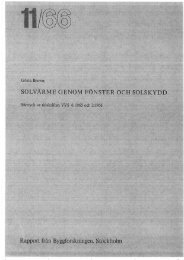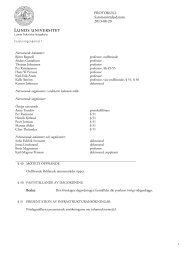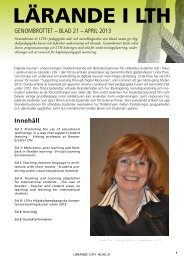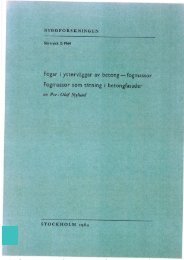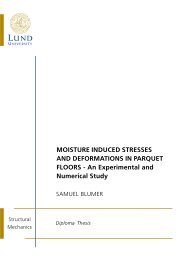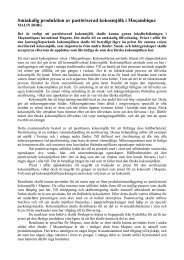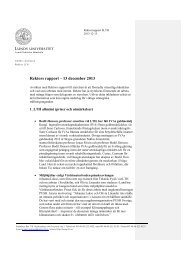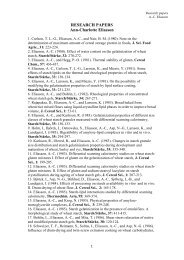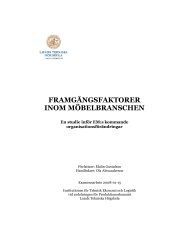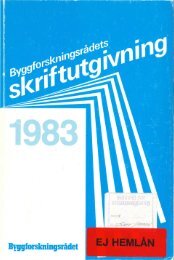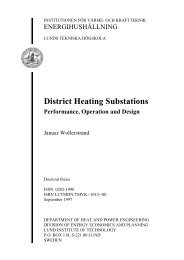User Experience Design at Sony Ericsson - Introducing the Virtual Pet
User Experience Design at Sony Ericsson - Introducing the Virtual Pet
User Experience Design at Sony Ericsson - Introducing the Virtual Pet
Create successful ePaper yourself
Turn your PDF publications into a flip-book with our unique Google optimized e-Paper software.
Bendek & Miner – Measuring Desirability<br />
Bendek & Miner (2002) work for Microsoft, where <strong>the</strong>ir team members often need to know more than if a<br />
product is usable. Traditional usability tests did not yield inform<strong>at</strong>ion on intangible experiences of users like if a<br />
product is fun, desirable and if users would consider buying it. As <strong>the</strong>y already have a usability lab, <strong>the</strong>y decided to<br />
try to develop a set of methods for quickly measuring desirability in a lab setting.8 usability practitioners<br />
brainstormed on how to measure desirability and two interesting ideas where selected and developed fur<strong>the</strong>r:<br />
The Faces Questionnaire and Product Reaction cards.<br />
The Faces Questionnaire<br />
The idea of using faces in a questionnaire was inspired by <strong>the</strong> work of psychology professor Paul Ekman, who has<br />
done extensive research on <strong>the</strong> connection between facial expressions and emotions. Six photographs of a woman<br />
showing ambiguous feelings are shown to users who r<strong>at</strong>e if <strong>the</strong>y think th<strong>at</strong> <strong>the</strong>ir feelings on an experience with a<br />
product or service m<strong>at</strong>ch <strong>the</strong> feelings displayed or not:<br />
Not<br />
<strong>at</strong> all<br />
like<br />
this<br />
1 2 3 4 5 6 7<br />
One of <strong>the</strong> questions from <strong>the</strong> faces questionnaire.<br />
Very<br />
much<br />
like<br />
this<br />
The result is a questionnaire th<strong>at</strong> uses Likert scales but where topics and anchors should be less dependent on<br />
practitioners, which could reduce bias.<br />
Product Reaction Cards<br />
The o<strong>the</strong>r method suggested is based on 118 cards labeled with different reactions th<strong>at</strong> a user can have to a<br />
product or service. After an experience, <strong>the</strong> cards are shown to users, who are asked to select <strong>the</strong> cards th<strong>at</strong> best<br />
describe <strong>the</strong> product and <strong>the</strong> way using <strong>the</strong> product made <strong>the</strong>m feel. Following this, <strong>the</strong> practitioner ask <strong>the</strong>m to<br />
narrow <strong>the</strong>ir choice down to 5 cards and to explain why <strong>the</strong>y chose each and one of <strong>the</strong>m.<br />
Accessible Desirable Gets in <strong>the</strong> way P<strong>at</strong>ronizing Stressful<br />
Appealing Easy to use Hard to use Personal Time-consuming<br />
Attractive Efficient High quality Predictable Time-saving<br />
Busy Empowering Inconsistent Relevant Too technical<br />
Selected words from <strong>the</strong> set of 118 product reaction cards.<br />
Comments<br />
The faces questionnaires is an interesting <strong>at</strong>tempt to make use of Likert scales without forcing users to accept<br />
topics and anchors specified by practitioners. However, it is not clear exactly wh<strong>at</strong> feelings <strong>the</strong> facial expressions<br />
portray, which could make it hard for designers to make real use of <strong>the</strong> d<strong>at</strong>a g<strong>at</strong>hered. To make <strong>the</strong> most of this<br />
promising method, <strong>the</strong> photographs will have to be developed more scientifically so th<strong>at</strong> <strong>the</strong>y with more certainty<br />
can be linked to precise descriptions of emotional st<strong>at</strong>es.<br />
The product reaction cards probably have <strong>the</strong>ir gre<strong>at</strong>est strength in th<strong>at</strong> users do not actively have to formul<strong>at</strong>e<br />
criticism, but r<strong>at</strong>her make a choice out of many ready-made adjectives. As users tend to give positive critique, <strong>the</strong><br />
cards are made up of 60% neg<strong>at</strong>ive and 40% positive judgments, making it more likely th<strong>at</strong> evalu<strong>at</strong>ion is<br />
ecologically relevant. Ano<strong>the</strong>r exciting use is to let designers choose cards th<strong>at</strong> m<strong>at</strong>ch <strong>the</strong>ir vision and keep track<br />
of how much overlap <strong>the</strong>re is between <strong>the</strong> two groups. Both <strong>the</strong>se methods offer new ways of making users talk<br />
about <strong>the</strong>ir experiences, and it might be valuable to try <strong>the</strong>m for <strong>the</strong>se properties alone.<br />
31



